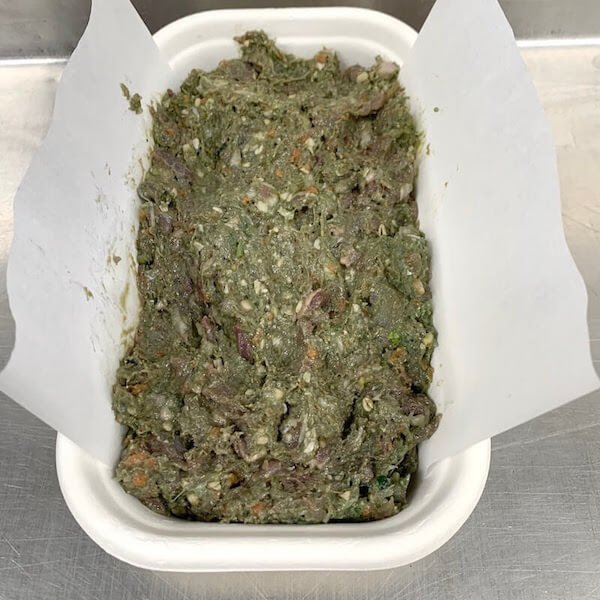How To Help A Dog With Food Allergies
In This Article
“My dog has skin issues and I think they have a food allergy.
PLEASE HELP!”
There is nothing worse than an itchy scratchy dog, especially when you think it could be something in their diet that is causing the issue. A lot of dogs are increasingly becoming unable to eat some foods, which can make dinnertime quite stressful - both for you and your dog.
Here are the key food sensitivity symptoms:
Constant scratching
Red ears or paws
Chewing or licking
Red stomach
If this is happening to your dog, there are things you can do to help! This article will cover what causes food allergies, and what you can to about it. It also looks at our Buffalo & Fish recipe which we have formulated especially to help itchy scratchy pups.
What is a food sensitivity?
A food allergy or sensitivity is actually an immune reaction the body mounts in response to a specific protein in the diet. This happens when your dog misidentifies a protein as a harmful invader instead of food. This is obviously not a normal or healthy occurrence!
The reason it does happen (and with increasing regularity) is predominantly due to the processing methods used in modern dog food manufacturing.
Here’s how it works. Protein is made up of chains of amino acids, which are “folded” into 3-dimensional shapes. Applying immense heat and pressure used in extrusion processes denatures the molecule - that is, it changes its shape. The result of this can be that your dog is unable to correctly identify it as it digestible food. Instead their body starts the defence mechanisms up, resulting in itchy skin, redness and all the awful things we want to avoid.
And unfortunately, once the body does this it learns that a particular protein is not suitable for digestion. That means that there are life-time consequences and you dog will likely never be able to eat that particular protein again without it causing the immune response.
A quick word about prevention
Before we move onto how to stop the scratching, it would be remiss to not discuss prevention. In my opinion the best way to stop food sensitivities from forming is to feed an unprocessed whole food diet. That means raw food, preferably organic and containing no synthetic vitamins or minerals. We obviously make amazing dog food at Whoa Nelly but if that isn’t available where you live, you should be able to find something else suitable.
What you really want to avoid is feeding processed food. This absolutely means anything shelf stable. The processes which the food must go through to make that possible quite often involve heating to above boiling point and then pushing it through a sieve. It’s no wonder that this “food” causes problems.
Raw is always best!
How to stop food allergies
The first step is to make sure that food is causing the issue - it could also be an environmental factor. The best way to do this is to feed a “novel protein” diet in a process that is known as an elimination diet.
A novel protein is a protein that your dog hasn’t eaten before. Because their body hasn’t digested it before, it won’t misidentify it and launch the immune reaction. Our Buffalo & Fish recipe is designed to help dogs with food sensitivities and should be good options if buffalo is a novel protein for your dog (which is most dogs).
If these are not novel proteins for your dog or your dog is experiencing severe inflammation caused by many foods, find a protein which is novel - venison for example, or crocodile in extreme cases. You can feed a simple diet based on this for the purposes of figuring out what foods are causing the sensitivity.
The Elimination Diet
STEP 1. Novel protein diet ONLY for 2 weeks.
The goal here is to remove as many foods as possible from the diet to minimise the potential immune triggers. I recommend feeding only their dinner, with no other foods. That means no snacks or scraps, bones or anything else - you need to be disciplined!
After 2 weeks of this simplified novel protein diet you should hopefully be seeing a reduction in symptoms. If so, excellent! We now know that it is food causing the issue and that the food you are feeding is proving some relief. If the reduction in symptoms is significant enough then we can now look at reintroducing foods into the diet to find which ones are causing the issue.
If you are not seeing a significant reduction in symptoms then the issue is more complex. Either there are still ingredients in the food causing the issues or there is another factor at play. I would suggest doing an audit of their environment for chemicals, dust, grass seeds (etc) to see if there is another likely cause. At this point it might be helpful to contact a vet or canine nutritionist to get professional support.
STEP 2. Reintroduce new foods - slowly!
Now that we have the problem stabilised, we can look at introducing foods into the diet with the goal of finding which ones are causing the sensitivity. Only feed one food at a time so you can track what foods work and what foods do not. This includes bones, snack, table scraps and treats. Remember to go slow!
If you think there are multiple foods that could be causing the issues, keep the diet the same and introduce new foods one at a time. Or if the issue isn’t as severe then you can try introducing our Kangaroo & Chicken or Beef & Chicken recipes. Feed the diet + extra food item only for one week and see if there are any changes. If there aren’t the food is ok, and if you see a resurgence in symptoms then you can put it on the “do not feed” list.
Using this process you can build up an idea of what foods do and do not work for your dog. Feeding a diet based on foods which they are easily able to digest is the best way to keep your dog healthy!
Our Solution: Buffalo & Fish
Food allergies and sensitivities is unfortunately something that is becoming increasingly common, and we are see a lot of itchy uncomfortable dogs (and distressed humans) looking for a solution. We have formulated our Buffalo & Fish recipe especially for these dogs.
This recipe uses wild sourced buffalo, which is a novel protein for most dogs and so doesn’t trigger the immune response. We pair this with sustainably sourced fish which is very anti-inflammatory and has a cooling effect on the body. Our secret ingredient is organic spirulina which has been shown to help reduce allergy symptoms. We also use local raw honey which can help neutralise seasonal allergies.
We have had amazing success in reducing itching for lots of our clients - in many cases the scratching goes away completely! If you thing your dog has food allergies or a sensitivity, this is the recipe we recommend feeding. For best (and fastest) results, remove all other food from the diet and feed Buffalo & Fish solely for at least 2 weeks. You should (hopefully) see some improvement over this time.
If you have more questions, you can contact us here.













